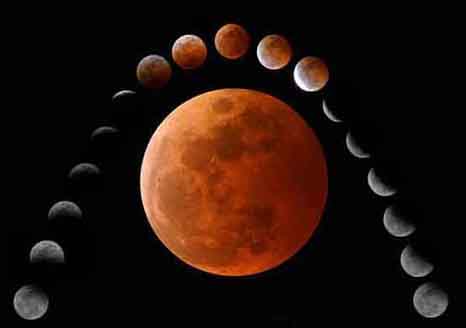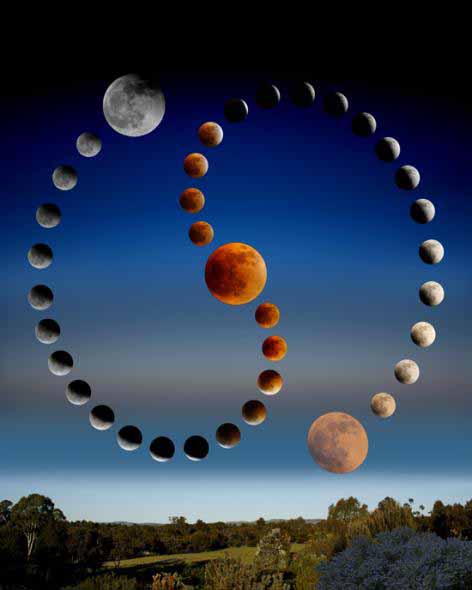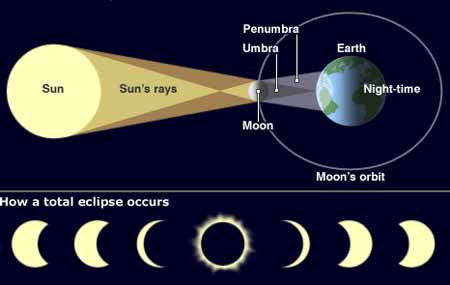


A lunar eclipse is
an eclipse which occurs whenever the moon passes behind the earth such that the
earth blocks the sunÕs rays from striking the moon. This can occur only when the
Sun, Earth, and Moon are aligned exactly, or very closely so, with the Earth in
the middle. Hence, there is always a full moon the night of a lunar eclipse. The
type and length of an eclipse depend upon the MoonÕs location relative to its
orbital nodes.
The shadow of the Earth can be divided into two distinctive parts: the umbra
and penumbra. Within the umbra, there is no direct solar radiation. However, as
a result of the SunÕs large angular size, solar illumination is only partially
blocked in the outer portion of the EarthÕs shadow, which is given the name
penumbra.
A penumbral eclipse occurs when the Moon passes through the EarthÕs penumbra.
The penumbra causes a subtle darkening of the Moon's surface. A special type of
penumbral eclipse is a total penumbral eclipse, during which the Moon lies
exclusively within the EarthÕs penumbra. Total penumbral eclipses are rare, and
when these occur, that portion of the Moon which is closest to the umbra can
appear somewhat darker than the rest of the Moon.
A partial lunar eclipse occurs when only a portion of the Moon enters the
umbra. When the Moon travels completely into the EarthÕs umbra, one observes a
total lunar eclipse. The MoonÕs speed through the shadow is about one kilometer
per second (2,300 mph), and totality may last up to nearly 107 minutes.
Nevertheless, the total time between the MoonÕs first and last contact with the
shadow is much longer, and could last up to 3.8 hours.
The relative distance of the Moon from the Earth at the time of an eclipse
can affect the eclipseÕs duration. In particular, when the Moon is near its
apogee, the farthest point from the Earth in its orbit, its orbital speed is the
slowest. The diameter of the umbra does not decrease much with distance. Thus, a
totally-eclipsed Moon occurring near apogee will lengthen the duration of
totality.

Eclipse Lunar
6:43 AM |
Read User's Comments(6)
Solar System
6:21 AM |


General Information
One of the most important features of every day life is the sun. It rises and sets, and we use it to fix our daily routine. Without it we would not receive the light and heat that provides us with energy. This star, our sun, is very unique. Most stars are visible only at night, but our sun is visible at daytime. It is the closest star to earth. Since the star is so close to us, we are able to know much about its surface.
Similar to all stars, the sun is a ball of hot gas. It has an interior as well as an atmosphere. The sun's surface is known as the photosphere. It's surface is largely uniform in brightness and becomes slightly darker on its edges. The sun has a few dark regions, called sunspots. These spots are cooler regions on its surface. Nuclear fusion is the process by which energy in the sun is formed. Groups of four hydrogen atoms are changed in to single helium atoms. Each sunspot also has a dark center, called the umbra and a less dark region, called the penumbra. These spots usually form in groups and can last for weeks. The sun rotates every 25 days, which allows us to watch the sunspots form and rotate across the surface. Sunspots are regions where the magnetic field is very strong, about 3000 times stronger than the average field of the sun or the earth. The sun is mainly composed of hydrogen and helium.
Its mean distance from the earth is one astronomical unit. It is 865,400 miles (1,392,000 km) in diameter with a volume that is about 1,300,000 times that of the earth. The sun has a temperature of about 15,000,000 degrees Kelvin. This high temperature helps with the nuclear reactions mentioned above. During a solar eclipse the chromosphere, a layer of gases above the photosphere, and the corona, an envelope of particles outside the chromosphere, can be observed.

General Information
Mercury is best known as the closest planet to the sun. Mercury’s mean distance from the sun is 36 million miles (57.9 million km) which is about half the distance from the sun to Venus. The orbit of Mercury is elliptical, with an eccentricity of 0.2056, zero being a perfect circle. The Earth’s own eccentricity is only 0.0167, much more circular than Mercury's. Mercury’s orbital distance varies from 28.6 million miles (46 million km) to 43.4 million miles (69.8 million km). Mercury has a diameter of 3,031 miles (57.9 km) which is two-fifths of Earth’s diameter.
General Information
Venus is the second planet from the sun. This planet is called the "twin" planet of Earth because they are so similar in size. It's diameter is about 7,520 miles (12,100 km), compared to the 7,926 mile (12,756 km) diameter of Earth, not that much smaller than Earth. Venus was named after the Roman goddess of love (the Greeks called her Aphrodite). Venus orbits in a nearly circular orbit around the sun. The distance from the sun varies from 67.7 million miles (108.9 million km) to about 66.8 million miles (107.5 million km). The average distance is about 67.2 million miles (108.2 million km) from the sun.

Intro:
The Earth is one of the most fascinating of all planets. It is the home of human beings and other living things. Why can this planet support life? The earth is a sphere covered with rock, water, soil and air. It is just the right distance away from the sun. We all need sunlight and warmth for life. If the earth was too close, it would be too hot for living things and if it were too far, it would be too cold. Also, water is a key element for all living things, and the earth has plenty.
The crust forms the surface of the earth. It is a thin layer of rock. Life on earth is either on the crust or in the water, which covers 70 percent of it. Below the crust is hot rock and below this is a ball of metal at the center.
The earth is the fifth largest planet and the third planet from the sun. Its diameter is 8,000 miles long. The earth is about 93 million miles from the sun. The atmosphere of Earth contains enough oxygen to sustain life. This can be compared to with other planets such as Mars, where it consists of only carbon dioxide.

Intro: Our obsession over Mars is a result of its closet proximity to us. The fourth planet from the sun and third smallest in our solar system, Mars is the only planet who's surface can be seen with great detail from Earth. It was the reddish color of Mars' surface that lead to its name- Mars was the Roman god of war. When it is at its closest, Mars is only a mere 34,600,000 (55,700,000 kilometers away). Venus is the only planet which comes closer to us.

Intro:
Jupiter is the largest of all the planets in the solar system, 318 times more massive than earth. It was named after the king of the Roman gods. Jupiter revolves around the sun with a radius that is five times that of the earth. Each year it appears to shift about 30 degrees eastward which helps create a 12 year cycle. Jupiter is actually composed of mostly hydrogen and helium, unlike Earth's rocky composition. The central temperature of Jupiter is about 20,000 degrees Kelvin, compared to 7000 degrees for earth and 15,000,000 degrees for the sun. The coloration of Jupiter is a result of the interaction of sunlight to the atmosphere and the clouds. Different chemicals absorb different colors of light.

Eclipses with Saturn
Eclipses are when a planet gets in between the earth and another object. The light of the other object, usually either the sun or the moon, is blocked by the planet. In a lunar eclipse, the moon is being blocked by another planet. In a solar eclipse, the sun is being blocked. A special kind of eclipse, a penumbral eclipse, is......
Some of the more recent lunar eclipses involving the planet Saturn:
- 7-17-81 Partial Lunar Eclipse
A partial lunar eclipse is when the moon is partially blocked by Saturn. - 7-6-82 Total Lunar Eclipse
A total lunar eclipse is when the moon is completely blocked by Saturn. This was observed on this date. - 11-18-94 Penumbral Eclipse
A penumbral eclipse occurred. - 9-27-96 Total Eclipse
The total eclipse occurred at about 8pm PST. - 3-24-97 Partial Eclipse
The moon was at a mid-eclipse at about 8:40pm PST and at about 9:00pm PST. This was observed on the same day that the Hale-Bopp comet was in the western sky

INTRO:
Uranus is the seventh planet from the sun. It is the farthest planet that can be seen without the use of a telescope. It is about 1,786,400,000 miles from the sun. It is a giant sphere made of gas and liquid. The diameter is 31,763 miles. The surface is made of blue-green methane clouds. Uranus was discovered in 1781. It is necessary that one carefully pronounces this planet's name in order to keep from embarassment. It is pronounced "YOOR a nus", not "your anus" or "urine us".

INTRO:
Neptune is the eighth planet from the sun. Along with Pluto, it is one of the only planets that can not be seen without a telescope. Neptune has a diameter of 30,500 miles. It has eight moons and several rings.
Like Earth, Neptune is almost completely composed of water. It is often referred to as one of the "Blue Planets." It is also one of the windiest planets in the solar system.
It travels around the sun in an elliptical orbit, and it revolves around the sun every 165 years. It takes this long because Neptune is 2,798,800,000 miles away from the sun. As it makes its revolution, it rotates on it's axis. The axis is at a tilt of 30 degrees to the perpendicular. Neptune makes one spin every 16 hours and 7 minutes.
12:11 AM |
WHAT ARE CONSTELLATIONS?
1. Constellations are a group of stars that form a pattern.
2. These stars produce their own light which makes them visible from the Earth.
3. Constellations are used to show direction and to remind the farmers of the time for harvesting and planting.
2. Examples of constellations are:
a) Big Dipper















2. These stars produce their own light which makes them visible from the Earth.
3. Constellations are used to show direction and to remind the farmers of the time for harvesting and planting.
2. Examples of constellations are:
a) Big Dipper


* A bowl with a handle
* Can be seen from April to June around 8 to 10 p.m
* Visibly only in the Northern Hemispere or North Pole
b)ORION



* A hunter with a belt and a sword.
* Can be seen from December to February
* Visibly in both Northern and Southern Hemispheres
c) SOUTHERN CROSS


* A cross or a diamond-shaped kite
* The smallest constellation among the 88 modern constellations.
* Can be seen from April to June around 8 - 10 p.m
* Visibly only in Southern Hemisphere.
d) Scorpion


* A scorpion with a head, long body, tail and sting.
* Can be seen from June to August around 8 - 10 p.m
e) URSA MAJOR or GREAT BEAR


* Also known as pointer stars because it points at Polaris
* Visible in the Northern Hemisphere throughout the year.
SEASON AND CONSTELLATION
1. SPRING - indicate by two constellation, Big Dipper and Southern Cross.

2. SUMMER - indicate by The Scorpio.

3. WINTER - indicate by The Orion.

4. AUTUMN @ FALLS - indicate by The Aquarius.

Just imagine, how our elders found their way home without these constellation? How they going to plant and harvest crops if they weren't indicator to specify the time of the year???
Be grateful of what we have and appreciate the contribution of the mother nature....
Subscribe to:
Posts (Atom)








